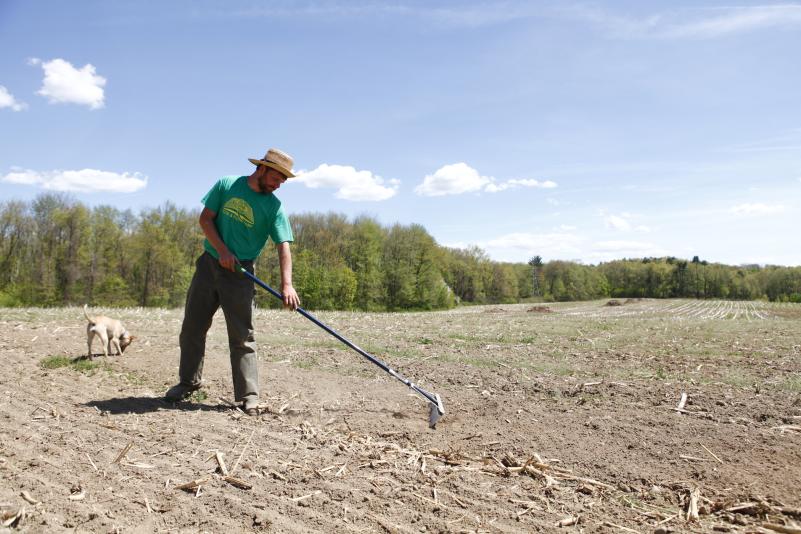Book and Plow: Farm to Val Table

My favorite surprises arise in finding complexity where I had previously assumed simplicity. Eating is such a simple act. It can be mindless and easy, quick and rewarding, but I consistently find myself marveling at the enormous disparity between the amount of time and effort required to create this sustenance and the rapidity with which we so often consume it. Take the apple I ate during class. I finished it within ten minutes, eating slowly as I rushed to take notes between noisy bites, but this piece of fruit only arrived at my disposal after months of hard work on the part of one apple tree and the dedication of various humans to maintain the tree, (picking the apple, washing it, packaging it, shipping it to Amherst) and finally the Valentine Hall staff who were kind enough to place this apple in the fruit basket above the bananas. That is a long chain of connections required to move one apple from its tree to my hand.
I once thought that I understood food production pretty well. At Book and Plow Farm, we grow food, we harvest it, we wash it and we deliver it to Val, where cooks wash it again and prepare it for the Amherst community’s consumption. Great, that makes sense, but what about the food that Pete and Tobin do not produce? How does the Book and Plow harvest fit into the rest of the menu? The second part of this question seems simple. Val just uses whatever Book and Plow gives them on any given day. Then again, think about how far in advance we know the menu at Val. I can tell you on Monday, Feb. 6 that dinner on Saturday, Feb. 22 will be kielbasa from the grill, pierogi with apple and caramelized onion, sauerkraut, and peas with onions. Of course, I never truly questioned the efforts involved in meal planning and food sourcing until I began working at Book and Plow this summer and witnessed the coordination efforts between farmers Pete and Tobin and our executive chef, Jeremy Roush.
Val serves 4,000 meals a day on average. At one dinner this week, we Amherst students consumed 300 pounds of strip loin and 250 pounds of sea trout. To feed our crowds, Jeremy has to plan, and plan and plan some more. He coordinates five different factors into acquiring fresh foodstuffs and producing a balanced diet with dishes that have lower ingredient profiles, meaning they are not heavily processed or pre-prepared foods. The first is customer satisfaction because he realizes that Val is an essential part of the student life; this is where we go to unwind after a long day, to relax, to chatter with our friends and to find nourishment. I personally love my long Val sits, and Jeremy understands this central aspect of the Amherst experience, so his goal is to provide us with refreshing, healthful, and new meals. Thus, Valentine follows a twenty-eight day cycle for menu planning, allowing students to know what will be served in the coming weeks and giving Val a structured plan for what to order when.
This plan moves us into the next two factors, purchasing and processing. There is no grocery story for Val, no place that will have enough of every ingredient required to make 4,000 meals in one day. Val begins preparing for meals ten days in advance, contacting suppliers and buying dry goods like flour and sugar. Four to five days ahead, Val has ordered the meat and may begin prepping it two to three days in advance. Luckily for us, Jeremy started a fish program about a year and a half ago that provides us with fresh fish and seafood, (except for shrimp), meaning that all of the fish we consume at Val has never been frozen but rather is processed and served the day it arrives. And this processing is another factor that Jeremy must incorporate into producing meals; these ingredients will not put themselves together. The Valentine staff must have the technical training to cut, process, cook and present food for 600 to 800 different recipes.
Book and Plow, the fifth and newest element. This past summer was our inaugural year, meaning farmers Pete and Tobin had no idea how successful farming in Amherst would even be. On a little over four acres of Amherst land, we grew 18,000 pounds of organic produce. Next year, with better knowledge of the land, the farm hopes to have between eight and ten acres growing fruits and vegetables, most of which will incorporate directly into the Valentine menu plan. Last week, Jeremy and Tobin met for three hours to discuss what Book and Plow can grow, what Valentine Hall wants and when and how to coordinate crop availability with dining hall requests for the year. This is an amazing relationship! Tobin, Jeremy and Pete can build a coordinated plan to incorporate Book and Plow produce regularly for meals at Amherst. They can grow to order. Obviously, there could be crop failure or overproduction or produce could be ready too soon — all natural occurrences at a farm — but for now Valentine Hall and Book and Plow have a partnership that will allow Jeremy to add more fresh ingredients to his daily menu, ones that are grown and harvested within walking distance of campus, under sustainable and organic practices and by two young and engaging farmers, who are wonderful assets to the Amherst College community.
And so, I have found the exciting complexity hidden within the simple act of eating a quick meal at Val. I am amazed at how much forethought and labor goes into each item I enjoy. While working at Book and Plow certainly gave me valuable insight into the system, I realize now that I was only touching the surface of a far larger operation. As much as I would love to think that the beauty of eating lies in the austerity of the process, I now knowit lies in the multitude of relationships among various people and factors that coordinate each meal we eat.





Comments ()